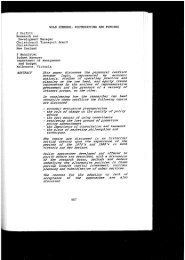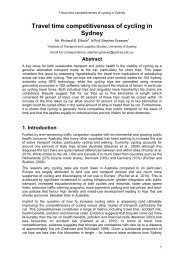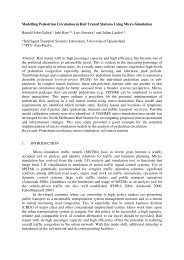PDF: 529 KB - ATRF.info
PDF: 529 KB - ATRF.info
PDF: 529 KB - ATRF.info
Create successful ePaper yourself
Turn your PDF publications into a flip-book with our unique Google optimized e-Paper software.
Conclusions<br />
Explanation oj urban travel increases<br />
The main aim of this paper has been to examine whether land-use can explain urban<br />
travel patterns in the five largest Australian cities Travel data were calculated for 1947<br />
and 1986 For 1986, the conventional inverse relationship between density and per<br />
capita travel was found, but in 1947, when public transport was dominant, the denser<br />
cities of Sydney and Melbourne had higher travel levels than the smaller, less dense<br />
capitals Further, over the period 1947-86, suburbanisation probably shortened the<br />
average distances between residencies and activities such as work and shopping, yet per<br />
capita travel grew apace<br />
Travel convenience was then proposed as the major factor influencing travel lt<br />
was able to explain both the higher travel levels in the larger cities in 1947 in terms of<br />
better public transport provision, and the reverse result in 1986 in terms of the superior<br />
traffic service levels in the smaller capitals Per capita travel growth over the period in all<br />
cities is matched by the evident increase in overall travel convenience accompanying the<br />
shift from public transport to cars<br />
The strong inverse correlation found between density and (car) travel per capita in<br />
Western cities is argued to result from the much higher levels of restraint on car travel<br />
provided by the more densely populated cities Although increasing the density of cities<br />
can in some circumstances reduce travel, it is inferior to direct measures to increase travel<br />
restraint, as these can be introduced both more rapidly and more cheaply.<br />
269





